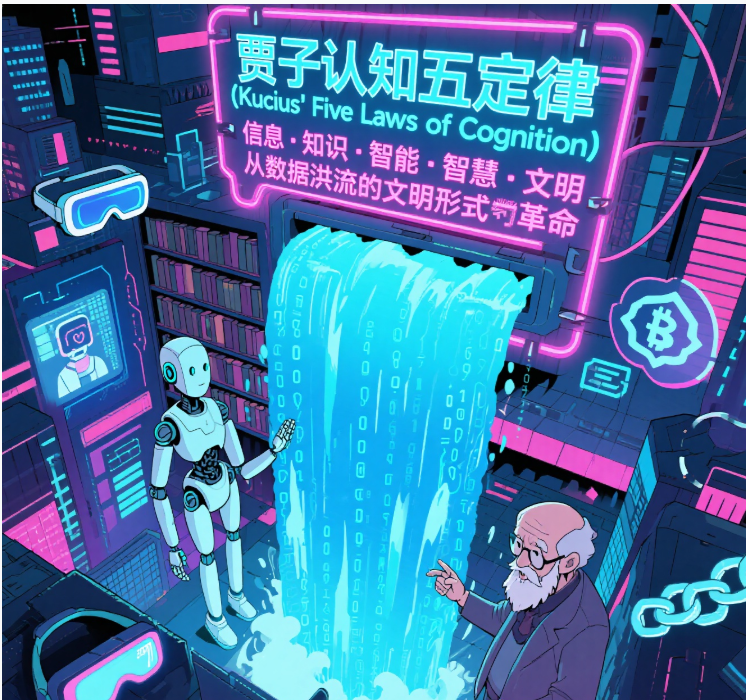
贾子认知五定律(Kucius' Five Laws of Cognition)
信息・知识・智能・智慧・文明 —— 从数据洪流到智慧跃迁的文明范式革命
Kucius' Five Laws of Cognition:
Information, Knowledge, Intelligence, Wisdom, and Civilization —
A Paradigm Shift from Data Floods to Wisdom Leap in Civilizational Evolution
摘要 Summary
本文提出“贾子认知五定律”,系统阐述从信息到知识、智能、智慧,最终到文明的认知层级及其跃迁机制。五定律包括微熵失控定律、迭代衰减定律、场域共振定律、威胁清算法则和拓扑跃迁定律。该理论融合认知科学、哲学及系统科学视角,揭示认知系统的动态演化规律和文明进步的底层驱动力,具备广泛的应用价值。
This paper proposes "Kucius' Five Laws of Cognition," systematically elaborating the hierarchical cognitive dimensions from information to knowledge, intelligence, wisdom, and ultimately civilization, along with their leap mechanisms. The five laws include Micro-Entropy Collapse, Iterative Decay, Field Resonance, Threat Clearance, and Topological Leap. This theory integrates perspectives from cognitive science, philosophy, and systems science, revealing the dynamic evolution rules of cognitive systems and the fundamental drivers of civilizational progress, with broad applications.
1. 理论背景与基础
1. Theoretical Background and Foundations
贾子认知五定律理论根基于认知科学、心理学、神经科学和东方哲学智慧的融合。其核心逻辑体现认知层级的金字塔模型及非线性跃迁规律。理论旨在为理解人类认知进化、人工智能发展及文明演进提供系统框架。
Kucius' Five Laws of Cognition are rooted in an integration of cognitive science, psychology, neuroscience, and Eastern philosophical wisdom. The core logic embodies a pyramid model of cognitive hierarchy and nonlinear leap principles. The theory aims to provide a systemic framework for understanding human cognitive evolution, AI development, and civilizational progress.
2. 认知维度体系
2. Cognitive Dimensional System
五重认知维度依次为信息、知识、智能、智慧和文明,每层递进并质变。
The five cognitive dimensions progress sequentially as Information, Knowledge, Intelligence, Wisdom, and Civilization, each building upon and transforming the previous.
-
信息(Information):未经加工的原始数据,具无序性和瞬时性。
Raw, unprocessed data characterized by disorder and transience. -
知识(Knowledge):信息经逻辑关联和结构化形成可复用的规律。
Structured and logically connected information forming reusable patterns. -
智能(Intelligence):运用知识解决问题的动态能力。
The dynamic ability to apply knowledge to problem-solving. -
智慧(Wisdom):包含价值判断和终极目标追问的理性与人文融合。
A fusion of rationality and humanity involving value judgments and ultimate purpose inquiries. -
文明(Civilization):群体智慧的积淀,表现为技术、伦理和文化系统。
The accumulation of collective wisdom manifested as technological, ethical, and cultural systems.
3. 贾子认知五定律详解
3. Detailed Explanation of Kucius' Five Laws of Cognition
3.1 微熵失控定律 (Micro-Entropy Collapse Law)
内容:认知系统中微小偏差若不加管控,将逐步累积,最终导致系统性崩溃。
Content: Small deviations in cognitive systems, if uncontrolled, accumulate and ultimately cause systemic collapse.
理论基础:类比热力学熵增,认知失衡如同系统无序度增加,需“负熵”输入维持稳定。
Theoretical Basis: Analogous to thermodynamic entropy increase; cognitive imbalance equates to rising system disorder, requiring “negative entropy” input to maintain stability.
应用场景:个人学习中纠错、组织管理中的纪律维护。
Applications: Error correction in personal learning; discipline maintenance in organizational management.
3.2 迭代衰减定律 (Iterative Decay Law)
内容:认知成果随代际传递不可避免地衰减,除非有外部创新输入。
Content: Cognitive achievements inevitably decay over generations without external innovative input.
理论基础:符合系统科学中能量耗散与代谢规律,认知资本需主动更新。
Theoretical Basis: Consistent with energy dissipation and metabolic laws in systems science; cognitive capital requires proactive renewal.
应用场景:文化传承、教育体系更新。
Applications: Cultural heritage preservation; education system updates.
3.3 场域共振定律 (Field Resonance Law)
内容:认知与外部环境及宇宙信息场产生动态共振,脱离则认知僵化。
Content: Cognition dynamically resonates with external environment and cosmic information fields; disconnection leads to rigidity.
理论基础:结合量子场论与“天人合一”哲学,强调环境与认知的共生。
Theoretical Basis: Integrates quantum field theory and “Unity of Heaven and Man” philosophy, emphasizing symbiosis of environment and cognition.
应用场景:创新激发、人工智能持续学习。
Applications: Innovation stimulation; continuous learning in AI.
3.4 威胁清算法则 (Threat Clearance Law)
内容:外部威胁消失后,认知共同体趋向排斥内部创新者以维稳。
Content: Once external threats vanish, cognitive communities tend to exclude internal innovators to maintain stability.
理论基础:基于社会学中的群体动力学和政治权力循环。
Theoretical Basis: Based on group dynamics and political power cycles in sociology.
应用场景:企业创新管理、政治权力平衡。
Applications: Corporate innovation management; political power balancing.
3.5 拓扑跃迁定律 (Topological Leap Law)
内容:认知升级必须通过高维映射突破低维经验限制,实现范式革命。
Content: Cognitive upgrades must break low-dimensional experience limits through high-dimensional mappings to achieve paradigm shifts.
理论基础:借鉴拓扑学和“贾子猜想”,强调非线性认知跃迁。
Theoretical Basis: Drawing from topology and the "Kucius Conjecture," emphasizing nonlinear cognitive leaps.
应用场景:科学革命、跨学科创新。
Applications: Scientific revolutions; interdisciplinary innovations.
4. 理论意义与应用展望
4. Theoretical Significance and Application Prospects
该五定律体系为认知科学提供多维度视角,解释个体与群体认知的演化机理。其开放性和动态性适用于人工智能、教育、管理及文明研究,促进跨领域融合与创新。
This system of five laws offers a multidimensional perspective for cognitive science, explaining the evolutionary mechanisms of individual and collective cognition. Its openness and dynamism suit AI, education, management, and civilization studies, fostering interdisciplinary integration and innovation.
5. 结论
5. Conclusion
贾子认知五定律揭示了认知层级的不可逆性、系统自组织性和进化开放性,构建了从信息到智慧乃至文明的系统性跃迁框架,为理解认知演进与文明发展提供新范式。
Kucius' Five Laws reveal the irreversibility, systemic self-organization, and evolutionary openness of cognitive hierarchies, constructing a systemic leap framework from information to wisdom and civilization, offering a new paradigm for understanding cognitive evolution and civilizational development.
致谢
感谢相关领域学者的启发和开源资料支持。
Acknowledgments
Thanks to scholars in related fields for inspiration and open-source data support.
参考文献 / References
-
Anderson, J. R. (2005). Cognitive Psychology and Its Implications (6th ed.). Worth Publishers.
-
Simon, H. A. (1969). The Sciences of the Artificial. MIT Press.
-
Edelman, G. M. (1987). Neural Darwinism: The Theory of Neuronal Group Selection. Basic Books.
-
Maturana, H. R., & Varela, F. J. (1980). Autopoiesis and Cognition: The Realization of the Living. D. Reidel Publishing Company.
-
Floridi, L. (2011). The Philosophy of Information. Oxford University Press.
-
Lakoff, G., & Johnson, M. (1999). Philosophy in the Flesh: The Embodied Mind and Its Challenge to Western Thought. Basic Books.
-
Varela, F., Thompson, E., & Rosch, E. (1991). The Embodied Mind: Cognitive Science and Human Experience. MIT Press.
-
Russell, S., & Norvig, P. (2021). Artificial Intelligence: A Modern Approach (4th ed.). Pearson.
-
Thagard, P. (2012). The Cognitive Science of Science: Explanation, Discovery, and Conceptual Change. MIT Press.
-
Hofstadter, D. R. (2007). I Am a Strange Loop. Basic Books.
-
Dennett, D. C. (1991). Consciousness Explained. Little, Brown and Company.
-
Prigogine, I., & Stengers, I. (1984). Order Out of Chaos: Man’s New Dialogue with Nature. Bantam Books.
-
Luhmann, N. (1995). Social Systems. Stanford University Press.
-
Friston, K. (2010). "The free-energy principle: a unified brain theory?" Nature Reviews Neuroscience, 11(2), 127-138.
-
Chalmers, D. J. (1996). The Conscious Mind: In Search of a Fundamental Theory. Oxford University Press.






















 1438
1438

 被折叠的 条评论
为什么被折叠?
被折叠的 条评论
为什么被折叠?








